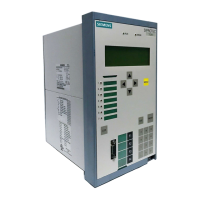
Do you have a question about the Siemens SIPROTEC 4 7SJ61 and is the answer not in the manual?
| Frequency | 50/60 Hz |
|---|---|
| Input Current | 1 A or 5 A |
| Current Inputs | 3 |
| Digital Inputs | 8 |
| Weight | Approx. 1.5 kg |
| Protection Functions | Overcurrent, earth fault |
| Communication Protocols | IEC 61850, DNP3, Modbus |
| Communication Interfaces | Ethernet, RS485 |
| Operating Temperature | -25 to +55 °C |
| Storage Temperature | -40 to +70 °C |
| Mounting | DIN rail mounting |
| Housing | Plastic |
Describes the manual's scope, covering functions, operation, installation, and commissioning of 7SJ61 devices.
Identifies intended readers: protection engineers, commissioning engineers, testing personnel, and operators.
Specifies the manual applies to SIPROTEC 4 7SJ61 with firmware version V4.9.
States compliance with EMC and Low-voltage directives, and relevant international/German standards.
Details the numerical, multi-functional SIPROTEC 7SJ61 device's hardware structure and microprocessor capabilities.
Describes the device's versatility for protection, control, and monitoring of busbar feeders and lines.
Outlines general device characteristics including microprocessor, digital processing, electrical separation, and ease of operation.
Explains how to modify device settings using DIGSI or the front panel, and the functional scope.
Covers the primary protection function of the 7SJ61 relay, detailing phase and ground current elements and their applications.
Explains how to dynamically adjust overcurrent protection pickup values for increased power consumption during starting.
Details the protection that evaluates current measured by sensitive or normal input, used for ground fault and tank leakage protection.
Covers protection that detects unbalanced loads, creating counter-rotating fields in induction motors and identifying phase faults.
Describes functions for motor protection, including starting protection, restart inhibit, and load jam protection.
Details the protection designed to prevent thermal overloads by creating a thermal replica of the equipment with memory capability.
Covers extensive monitoring capabilities for hardware and software, including measured values and transformer circuits.
Explains protection designed for ground fault detection in isolated or compensated systems, sensitive to high impedance ground faults.
Describes a protective function to detect and accumulate intermittent ground faults, assessing thermal load capacity.
Details the integrated three-pole, single-shot, and multi-shot automatic reclosure (AR) function for overhead lines.
Monitors proper tripping of the circuit breaker and issues a trip signal to isolate the failure breaker if it hasn't opened.
Allows creation and configuration of up to 20 flexible protection functions, usable as autonomous or additional protective elements.
Describes the use of an RTD box with 12 measuring sensors for temperature detection and monitoring of motors, generators, and transformers.
Explains the function that checks phase rotation via binary input and parameter for correct operation of protective and monitoring functions.
Coordinates execution of protection and auxiliary functions, processing decisions and system information, including pickup and tripping logic.
Covers functions like message processing, measurements, setpoints, statistics, commissioning aids, and clock synchronization.
Details how switchgear can be controlled via operator panel, PC, or system interface, including interlocking and command sequences.
Provides information on installation prerequisites, general diagrams, binary inputs/outputs, and setting group changes.
Covers checking data connections of interfaces, system connections, and verifying circuit breaker auxiliary contacts.
Details procedures for testing the device, including test mode, system interface, binary inputs/outputs, and breaker failure protection.
Provides electrical and functional data, including analog inputs, auxiliary voltage, binary inputs/outputs, and communication interfaces.
Details operating modes, measuring methods, setting ranges, increments, and tolerances for definite-time overcurrent protection.
Covers operating modes, measuring methods, setting ranges, increments, trip time curves, and dropout characteristics for inverse-time overcurrent protection.
Explains the function to prevent false tripping due to inrush currents by evaluating the 2nd harmonic component.
Describes the timed changeover of settings for overcurrent protection to dynamically adjust pickup values.
Details current elements, operating times, dropout ratios, and influencing variables for single-phase overcurrent protection.
Covers setting ranges, increments, functional limits, and tolerances for definite-time negative sequence protection.
Details setting ranges, increments, trip time curves, and dropout time curves for inverse-time negative sequence protection.
Provides setting ranges, increments, trip curve, dropout ratio, tolerances, and influencing variables for motor starting supervision.
Covers setting ranges, increments, restart threshold, and influencing variables to prevent motor restart if thermal limits are exceeded.
Details setting ranges, increments, timers, dropout ratio, tolerances, and influencing variables for detecting locked rotors.
Explains the protection designed to prevent thermal overloads by creating a thermal replica of the equipment with memory capability.
Covers pickup current and time delay settings for definite-time and inverse-time characteristics of ground fault detection.
Details pickup thresholds, times, tolerances, and influencing variables for detecting and accumulating intermittent ground faults.
Covers number of reclosures, blocking, dead times, reclosing programs, and controlling protective functions.
Details setting ranges, increments, times, tolerances, and influencing variables for breaker failure protection.
Describes modes of operation, measured quantities, measurement methods, and settings for flexible protection functions.
Details connectable RTD-box, number of sensors, measuring method, operational measured values, and indication thresholds.
Explains function blocks and their possible assignments to task levels, including device-specific CFC blocks.
Covers message processing, measurements, setpoints, statistics, commissioning aids, and clock synchronization.
Details control logic, switching modes, zone controlled/field interlocking, system interlocking, and double activation blockage.
Provides dimensional drawings for panel flush, cubicle, and surface mounting housings.
Lists multi-functional protection with control, number of binary inputs/outputs, nominal current, auxiliary voltage, and system interfaces.
Lists available accessories such as interface modules, RTD-boxes, terminal block covering caps, short-circuit links, and female plugs.
Provides connection diagrams for 7SJ610*-*D/E and 7SJ611/3*-*D/E in panel flush or cubicle mounted configurations.
Shows connection diagrams for 7SJ610*-*B and 7SJ611/3*-*B in panel surface mounted configurations.
Details terminal assignments for 7SJ610/1/2*-*B and 7SJ610/1/2/3/4*-*B (release /DD and higher) panel surface mounted devices.
Lists connector assignments for RS232, RS485, Profibus, DNP3.0, Modbus, IEC 60870-5-103, and Ethernet interfaces.
Illustrates current transformer connections for three current transformers, neutral point current, two current transformers, and summation CTs.
Shows half-duplex operation with one RTD-Box, including optical and RS485 cable connections.
Explains required minimum effective accuracy limiting factor and resulting rated accuracy limiting factor, with calculation examples.
Provides conversion formulas for current transformer classes according to British Standard BS 3938, ANSI/IEEE C 57.13, and IEC 60044-6.
Details requirements for cable core balance current transformers for sensitive ground fault detection and class accuracy.
Lists preset LED displays for different functions like Relay TRIP, Overcurrent, Ground Fault, and Motor Protection.
Shows binary input presettings for various devices and ordering variants, including >BLOCK, >Reset LED, and >52-a/b contacts.
Lists output relay presettings for functions like Relay TRIP, Breaker status, Automatic Reclosing, and Overload Protection.
Details the default functions assigned to Function Keys F1 through F4 for device operation.
Describes predefined measured value pages available on 4-line and graphic displays, including startup display selection.
Introduces pre-defined CFC charts installed upon delivery, covering device and system logic, and set points for measured values.
Summarizes protocol-dependent functions for various communication protocols like IEC 60870-5-103, IEC 61850, PROFINET, PROFIBUS, DNP3, and Modbus.
Details parameters for configuring the functional scope, including overcurrent, ground fault, motor, and flexible protection functions.
Provides a comprehensive list of parameters, their functions, setting options, default settings, and comments across various protection and control functions.
Lists information provided by the device, categorized by function, log buffers, configurable matrix, and IEC 60870-5-103 data.
Lists group alarms and their composition, noting that Alarm Sum Event is issued only when measured value monitoring functions are activated.
Describes operational measured values, long-term averages, and min/max reports, including how to set points for measured values.

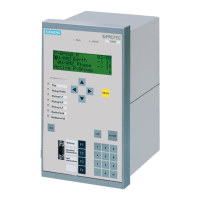
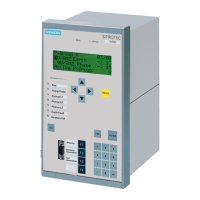
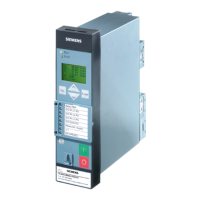
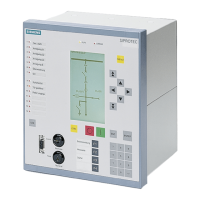
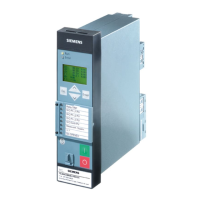
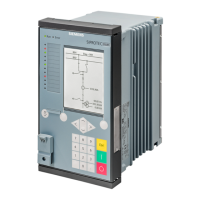

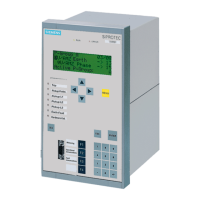

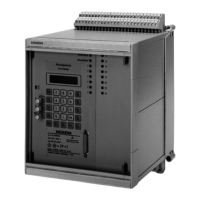
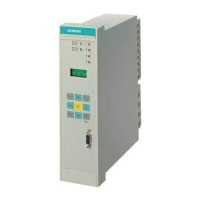
